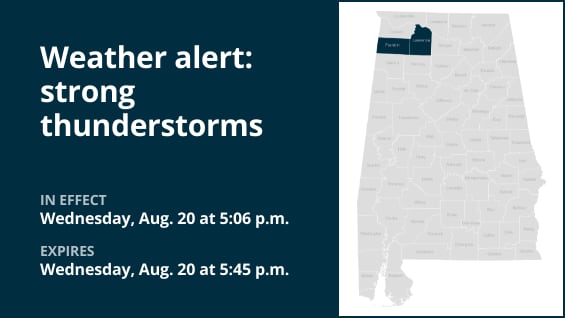At 5:06 p.m. on Wednesday, the National Weather Service released a forecast for Franklin and Lawrence counties that called for heavy thunderstorms until 5:45 p.m.
Be prepared for wind gusts of up to 50 mph and pea-sized hail (0.25 inches).
“At 5:06 p.m., Doppler radar tracked a strong thunderstorm 8 miles east of Phil Campbell, or 11 miles north of Haleyville, moving south at 15 mph,” according to the National Weather Service. Gusty winds have the potential to blow around unsecured objects and topple tree branches. There is a chance of minor hail damage to vegetation.
Russellville, Moulton, Phil Campbell, Mt Hope, Speake, Isbell, Bankhead National Forest, Spruce Pine, Wren, and Landersville are among the places affected by the alert.
“If outside, consider seeking shelter inside a building,” the weather agency advises. Alongside this storm is torrential rain, which could cause localized flooding. Avoid operating a car on flooded roads.
When lightning looms: Expert safety tips for thunderstorms
About 25 million lightning strikes occur in the US annually, primarily in the summer. The weather service estimates that it kills around 20 people a year. As thunderstorms get closer, the risk of lightning increases; it peaks when the storm is directly overhead and then progressively decreases as it passes.
Consider the following advice to keep yourself safe during a thunderstorm:
Plan for lightning safety:
-
When venturing outdoors, it’s vital to establish a clear plan for seeking shelter in case of lightning.
-
Monitor the sky for threatening signs and listen for the sound of thunder. If thunder is audible, it’s an indication that lightning is nearby.
-
Seek shelter promptly in a safe location, preferably indoors.
Indoor safety precautions:
-
Once you’re indoors, avoid using corded phones, electrical devices, plumbing fixtures, and stay away from windows and doors.
-
Lightning can follow conductive pathways, and these precautions reduce the risk of electrical surges.
Hold off till the all-clear:
-
After the last lightning strike or thunderclap, wait at least 30 minutes before resuming outdoor activities.
-
It’s important to remember that lightning can strike even when a storm seems to have passed, so exercise caution.
When there is no indoor shelter:
Take these precautions to increase your safety if you are outside during a thunderstorm without access to indoor shelter:
-
Avoid open fields, hilltops, or ridge crests, as they expose you to greater lightning risk.
-
Steer clear of tall, isolated trees and other prominent objects. In forested areas, stay close to lower stands of trees.
-
If you’re in a group, ensure that individuals are spaced out to prevent lightning current from transferring between people.
-
Camping in an open setting during a thunderstorm is strongly discouraged. If you have no alternative, set up camp in a valley, ravine, or other low-lying areas. It’s crucial to note that a tent provides no protection against lightning.
-
Do not approach water bodies, wet objects, or metal items. Although water and metal do not attract lightning, they conduct electricity effectively and can pose significant risks.
In conclusion, being alert and ready are your best defenses against lightning threats. You may put your safety first and drastically lower the likelihood of lightning-related mishaps by adhering to these rules.
Driving through downpours: Safety guidelines for wet roads
Roads can become dangerous when it rains. Keep yourself updated and heed these weather service recommendations to stay safe during periods of intense precipitation:
Watch out for swift water flow:
When it rains a lot, stay clear from parking or strolling near culverts or drainage ditches since the swift-moving water could carry you away.
Keep your distances from other vehicles safe:
In heavy rain, the two-second rule of following distance is your friend. To guarantee safe spacing under unfavorable circumstances, increase it to four seconds.
Reduce your speed and drive carefully:
It’s crucial to slow down on wet roads. To avoid sliding, reduce the accelerator gradually and don’t brake suddenly.
Pick your lane carefully:
Water tends to pool in the outside lanes, so stick to the central ones.
Put visibility first.
Turn on your headlights to improve visibility in severe rain. Rain-stained windows can hide cars in blind zones, so be cautious.
Be cautious on slick roads:
Roads are slickest during the first half-hour of rain because of a combination of rain, oil, and filth. Be especially careful during this time.
Stay a safe distance away from big cars:
Tire spray from big vehicles and buses can make it harder to see. Be careful when passing and refrain from tailgating.
Be mindful of your wipers:
The wiper blades may be overloaded by heavy rain. It’s time to stop and wait for the rain to stop when visibility is so poor that you can’t see other cars or the road’s borders from a safe distance. Stopping at rest areas or other sheltered spaces is the best option.
If you can’t avoid the roadside, pull off as far as you can, ideally past the end of a guard rail, and wait for the storm to pass. To let other cars know where you are, turn on your emergency flashers and keep your headlights on.
You may greatly lower dangers and protect your health when it rains a lot by adhering to these safety precautions. To ensure a safe and sound voyage, keep yourself updated on weather conditions and follow local authorities’ instructions.
United Robots offers a service called Advance Local Weather Alerts that gathers the most recent information from the National Weather Service using machine learning.






